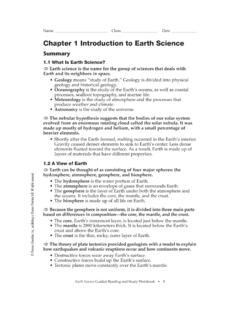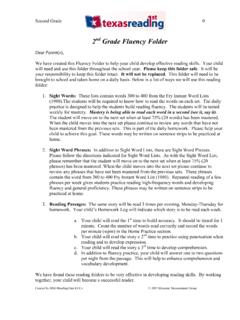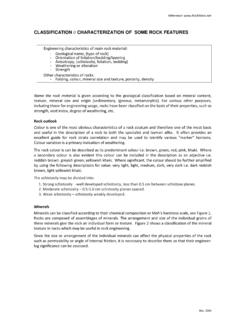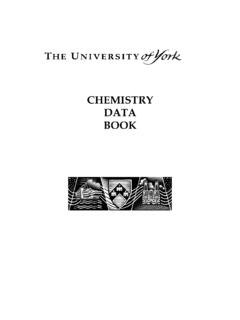Transcription of Chapter 1 Introduction to Earth Science
1 Name _____Class _____Date _____ Pearson Education, Inc., publishing as Pearson Prentice Hall. All rights ScienceGuided Reading and Study Workbook 1 IPLSC hapter 1 Introduction to Earth ScienceSummary What Is Earth Science ? Earth Science is the name for the group of sciences that deals withEarth and its neighbors in space. Geologymeans study of Earth . Geology is divided into physicalgeology and historical geology. Oceanographyis the study of the Earth s oceans, as well as coastalprocesses, seafloor topography, and marine life. Meteorologyis the study of atmosphere and the processes thatproduce weather and climate. Astronomyis the study of the nebular hypothesis suggests that the bodies of our solar systemevolved from an enormous rotating cloud called the solar nebula. It wasmade up mostly of hydrogen and helium, with a small percentage ofheavier elements. Shortly after the Earth formed, melting occurred in the Earth s caused denser elements to sink to Earth s center.
2 Less denseelements floated toward the surface. As a result, Earth is made up oflayers of materials that have different A View of EarthEarth can be thought of as consisting of four major spheres: thehydrosphere, atmosphere, geosphere, and biosphere. The hydrosphereis the water portion of Earth . The atmosphereis an envelope of gases that surrounds Earth . The geosphereis the layer of Earth under both the atmosphere andthe oceans. It includes the core, the mantle, and the crust. The biosphereis made up of all life on the geosphere is not uniform, it is divided into three main partsbased on differences in composition the core, the mantle, and the crust. The core, Earth s innermost layer, is located just below the mantle. The mantleis 2890 kilometers thick. It is located below the Earth scrust and above the Earth s core. The crustis the thin, rocky, outer layer of theory of plate tectonics provided geologists with a model to explainhow earthquakes and volcanic eruptions occur and how continents move.
3 Destructive forces wear away Earth s surface. Constructive forces build up the Earth s surface. Tectonic plates move constantly over the Earth s 7/26/07 3:29 PM Page 1 Name _____Class _____Date _____Chapter 1 Introduction to Earth Science Pearson Education, Inc., publishing as Pearson Prentice Hall. All rights ScienceGuided Reading and Study Workbook Representing Earth s SurfaceLatitude is the distance north or south of the equator, measured indegrees. Longitude is the distance east or west of the prime meridian,measured in degrees. The equator divides Earth into two hemispheres the northern andthe southern. The prime meridian and the 180 meridian divide Earth into easternand western matter what kind of map is made, some portion of the surface willalways look either too small, too big, or out of place. Mapmakers have,however, found ways to limit the distortion of shape, size, distance, maps show elevation using contour lines. Atopographic maprepresents Earth s three-dimensional surface intwo dimensions.
4 Acontour lineindicates the elevation of the land. Acontour intervaltells the difference in elevation between adjacentcontour lines. A scale helps to determine distances on a geologic map shows the type and age of exposed s technology provides us with the ability to more preciselyanalyze Earth s physical properties. Satellites and computers provide more accurate Earth System ScienceEarth system Science aims to understand Earth as a system made up ofinteracting parts, or system can be any size group of interacting parts that form acomplex whole. In a closed system, matter does not enter or leave the system. In an open system, energy and matter flow into and out of the system. Most natural systems are open systems. The Earth system is powered by energy from two source of energy for Earth systems is the sun, which drives externalprocesses that occur in the atmosphere, hydrosphere, and at Earth s surface. The sun s energy drives weather, climate, ocean circulation, and erosion.
5 7/26/07 3:29 PM Page 2 Name _____Class _____Date _____Chapter 1 Introduction to Earth Science Pearson Education, Inc., publishing as Pearson Prentice Hall. All rights ScienceGuided Reading and Study Workbook 3 IPLSE arth s interior is the second source of energy for Earth systems. Heat powers the internal processes that cause volcanoes, earthquakes,and mountains. The Earth system s processes are interlinked. A change in one part ofthe system can affect the whole actions produce changes in all of the other parts of the Earth system. Environment refers to things that surround and influence an organism. Environmental Science focuses on the relationships between peopleand Earth . Resources include water, soil, metallic and nonmetallic minerals, resources can be replenished over relatively short time spans. Plants, animals, and energy such as water, wind, and the sun are someexamples of renewable these and other resources continue to form, the processesthat create them are so slow that it takes millions of years for significantdeposits to accumulate.
6 Iron, aluminum, copper, oil, natural gas, and coal are examples ofnonrenewable resources. Population growth equals an increase in demand for threats to the environment include air pollution, acid rain,ozone depletion, and global warming. Understanding Earth s environment and the impact of humans on limitedresources is necessary for the survival and well-being of the What Is Scientific Inquiry?Once data have been gathered, scientists try to explain how or whythings happen in the manner observed. Scientists do this by stating apossible explanation called a scientific hypothesis. A hypothesis becomes a scientific theory if it survives tests scientific theory is well tested and widely accepted by the scientificcommunity and best explains certain observable facts. Scientific investigations often have four steps collecting facts;developing a hypothesis; observing and experimenting; andaccepting, modifying, or rejecting the 7/26/07 3:29 PM Page 3 Name _____Class _____Date _____ Pearson Education, Inc.
7 , publishing as Pearson Prentice Hall. All rights ScienceGuided Reading and Study Workbook 15 IPLSC hapter 2 MatterAn element is a substance that cannot be broken down into simplersubstances by chemical or physical atom is the smallest particle of matter that contains thecharacteristics of an element. The central region of an atom is called the nucleus. The nucleuscontains protons and neutrons. The number of protons in the nucleus of an atom is called the atomicnumber. Electrons are located in regions called energy with the same number of protons but different numbers ofneutrons are isotopes of an element. The mass numberof an atom is the total mass of the atom expressedin atomic mass units. Many elements have atoms whose nuclei are unstable. These atomsdisintegrate by radioactive compound is a substance that consists of two or more elements thatare chemically combined in specific an atom s outermost energy level does not contain the maximumnumber of electrons, the atom is likely to form a chemical bond with oneor more other atoms.
8 Chemical combinations of the atoms of elements are calledcompounds. Chemical bondsare the forces that hold atoms together in acompound. There are three principal types of chemical bonds: ionic,covalent, and metallic. An atom can gain or lose one or more electrons. The atom then has anelectrical charge and is called an bonds form between positive and negative bonds form when atoms share bonds form when electrons are shared by metal 7/26/07 3:29 PM Page 15 Name _____Class _____Date _____Chapter 2 Minerals Pearson Education, Inc., publishing as Pearson Prentice Hall. All rights ScienceGuided Reading and Study Workbook MineralsA mineral is a naturally occurring, inorganic solid with an orderlycrystalline structure and a definite chemical composition. Minerals form by natural processes. Minerals are solids in normal temperature ranges on Earth . Minerals are crystalline. Their atoms or ions are arranged in anorderly and repetitive way. Minerals have definite chemical composition.
9 They usually arecompounds formed of two or more elements. Most minerals are inorganic chemical compounds. There are four major processes by which minerals form: crystallizationfrom magma, precipitation, changes in pressure and temperature, andformation from hydrothermal solutions. Magma is molten rock from deep in the Earth . As it cools, it formsminerals. Substances dissolved in water may react to form minerals. Changes in temperature and pressure can make new minerals form. When hot solutions touch exisiting minerals, chemical reactions takeplace and form new minerals, together with the thousands of others that form onEarth, can be classified into groups based on their and oxygen combine to form a structure called the silicon-oxygen tetrahedron. Silicatesare made of silicon and oxygen. They are the most commongroup of minerals on Earth . Most silicate minerals crystallize from cooling are minerals that contain the elements carbon, oxygen, andone or more other metallic are minerals that contain oxygen and one or more otherelements, which are usually and sulfides are minerals that contain the element are minerals that contain a halogen ion plus one or more elements are minerals that only contain one element or type 7/26/07 3:29 PM Page 16 Name _____Class _____Date _____Chapter 2 Minerals Pearson Education, Inc.
10 , publishing as Pearson Prentice Hall. All rights ScienceGuided Reading and Study Workbook Properties of MineralsSmall amounts of different elements can give the same mineraldifferent is the color of a mineral in its powdered is used to describe how light is reflected from the surface of form is the visible expression of a mineral s internalarrangement of mohs scale consists of 10 minerals arranged from 10 (hardest) to 1(softest). Hardnessis a measure of the resistance of a mineral to beingscratched. You can test hardness by rubbing a mineral against another mineral ofknown hardness . One will scratch the other, unless they have the is the tendency of a mineral to cleave, or break, along flat,even surfaces. Minerals may have cleavage in one or more that do not show cleavage when broken are said to fracture. Fractureis the uneven breakage of a is a property of all matter that is the ratio of an object s massto its minerals can be recognized by other distinctive 7/26/07 3:29 PM Page 17 Name _____Class _____Date _____ Pearson Education, Inc.








